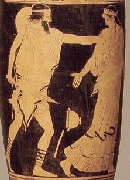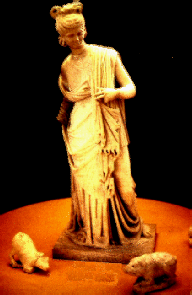Labate, Mario: Storie di instabilità. L'episodio di Ermafrodito nelle Metamorfosi di Ovidio. MD 30 (1993) 49-62.
Lafaye G.: Les Métamorphoses d'Ovide et leurs modèles grecs. Paris 1904.
Landolfi, L.: Un modulo epico-tragico in Ovidio (Met. IV, 680-681). in: Mathesis e Philia. Studi Gigante. Napoli 1995. 43-52.
Landolfi, L.: Forma duplex (Ov. Met. 4,378). Salmacide, Ermafordito e l'irbida metamorfosi. BollStudLat 32 (2002) 406-423.
Lange, Adolf: Methodischer Lehrer-Kommentar zu Ovids Metamorphosen. 1. Heft: Buch I-V. Gotha 1892.
Larmour, D.H.J.: Tragic Contaminatio in Ovid's Metamorphoses. Procne and Medea, Philomela and Iphigeneia (6.424-674); Scylla and Phaedra (8.19-51). ICS 15 (1990) 131-141.
Latacz, Joachim: Ovids "Metamorphosen" als Spiel mit der Tradition. WJA NF 5 (1979) 133-155.
Lateiner, Donald: Mythic and Non-Mythic Artists in Ovid's Metamorphoses. Ramus 13 (1984) 1-30.
Lateiner, Donald: Nonverbal Behaviors in Ovid's Poetry, Primarily Metamorphoses 14. CJ 91 (1996) 225-254.
Lateiner, Donald: Transsexuals and Transvestites in Ovid's Metamorphoses, in: Bodies and Boundaries in Graeco-Roman Antiquity. Ed. by Thorsten Fögen and Mireille M. Lee. Berlin / New York 2009, 125-152.
Donald Lateiner: Mimetic Syntax: Metaphor from Word Order, especially in Ovid, AJPh 111 (1990) 204-237.
Lather, Ralph: Kein Ovid. Nirgends. Kunst und Leben in Christoph Ransmayrs "Die letzte Welt" und Ovids zweitem Tristienbuch, in: Aquilonia 2008. Beiträge, präsentiert zum 13. Jahrestreffen der Klassischen Philologie in Ostdeutschland. Hrsg. von Ursula Gärtner und Ute Tischer. Frankfurt a. M. 2009, 73-94.
Lausberg, Marion: Ein epigrammatisches Motiv in Ovids Metamorphosen. GB 10 (1981) 181-191.
Lausberg, Marion: Zur Bildbeschreibung bei Ovid, Boreas 5 (1982) 112-123.
Leach, Eleanor Winsor: Ekphrasis and the Theme of Artistic Failure in Ovid's Metamorphoses. Ramus 3 (1974) 102-142.
LeBonniec, Henri: Apollon dans les Métamorphoses d'Ovide. in: Journées Ovidiennes. 145-174.
Lee, A.G.: P. Ovidi Nasonis Metamorphoseon Liber I. Cambridge 1953.
Leigh, Matthew: Two notes on Ovid. CQ 50 (2000) 311-313.
Leigh, Matthew: Ovid and the Lectisternium (Metamorphoses 8. 651-60). CQ 52 (2002) 625-627.
van Leijenhorst, C.G.: Nogmaals: Pyramus en Thisbe. Lampas 11 (1978) 218-221.
Lenoir, G.: La fuit de Médée (Ovide, Metamorphoses VII,350-392). in: R. Chevallier (ed.): Colloque Présence d'Ovide. Paris 1982 (Caesarodunum XVII bis) 51- 56.
Lieberg, Godo: Apotheose und Unsterblichkeit in Ovids Metamorphosen. in: Silvae. Festschrift für Ernst Zinn zum 60. Geburtstag. Tübingen 1970. 125-135.
Lieberg, Godo: "Ovide et les Muses." LEC 48 (1980) 3-22.
Lieberg, Godo: Zur Kombination literarischer Gattungen. Ovids Erzälung von Philemon und Baucis ("Metamorphosen", VIII, 611-728). Aevum 54 (1980) 35-45.
Godo Lieberg: Das Verhältnis der Metapher und des Vergleichs zur Metamorphose in den Metamorphosen Ovids, in: Ovid. Werk und Wirkung. Festgabe für Michael von Albrecht zum 65. Geburtstag. Frankfurt et al. 1999 (Studien zur klassischen Philologie) 343-358.
Lénard, E.: Répertoires prosodiques et métriques. II. Ovide, "Métamorphoses", VI; Lucain, "Pharsale", V; Sidoine Apollinaire; Panegyricus , V. Bruxelles 1980 (ULB. Faculté de Philosophie et Lettres. Sources et instruments, 5).
Little D.A.: The Structural Character of Ovid's Metamorphoses. Diss. Univ. of Texas 1972.
Little, Douglas A.: Ovid's Eulogy of Augustus. Metamorphoses 15.851-70. Prudentia 8 (1976). 19-35.
Little, Douglas A.: The Non-Augustanism of Ovid's Metamorphoses. Mnemosyne (ser. IV.) 25 (1972) 389-401.
Little, Douglas A.: The Speech of Pythagoras in Metamorphoses 15 and the Structure of the Metamorphoses. Hermes 98 (1970) 340-360.
Genevieve Liveley: Reading resistance in Ovid's Metamorphoses. in: Ovidian Transformations. Essays on Ovid's Metamorphoses and its reception. Ed. by Philip Hardie, Alessandro Barchiesi, Stephen Hinds. Cambridge 1999 (Cambridge Philological Society Supp. Vol.23) 197-213.
Genevieve Liveley: Tiresias-Teresa: A Man-made-woman in Ovid's Metamorphoses 316-338, Helios 30 (2003) 147-162.
Loehr, Johanna: Ovids Mehrfacherklärungen in der Tradition aitiologischen Dichtens. Stuttgart, Leipzig 1996 (Beiträge zur Altertumskunde 74).
Lohmann, Dieter:Auf Neues habe ich Lust - Über die Bedeutung der Reihenfolge für das Verstehen und Übersetzen, dargestellt an deutschen und lateinischen Text-Beispielen von Ovid bis Horaz, Forum Classicum 50 (2007) 164-175.
Lowrie, Michéle: Myrrha's Second Taboo, Ovid Metamorphoses 10.467-68. CPh 88 (1993) 50-52.
de Luce, J.: "O for a Thousand Tongues to Sing": A Footnote on Metamorphosis, Silence, and Power. in: Woman's Power, Man's Game. Waucanda 1993.. 305-321.
Luck, Georg: Zum Prooemium von Ovids Metamorphosen. Hermes 86 (1958) 499f.
Luck, Georg: Notes on the text of Ovid's metamorphoses. Exemplaria Classica. Revista Internacional de Literatura Comparada 12 (2008)49-67.
Ludwig, Walther: Struktur und Einheit der Metamorphosen. Berlin 1965.
Lundström, Sven: Ovids Metamorphosen und die Politik des Kaisers. Uppsala 1980 (Acta Universitatis Upsaliensis. Studia Latina Upsaliensia 12).
Lyne, R.O.A.M.: Ovid's Metamorphoses, Callimachus, and l'art pour l'art. MD 12 (1984) 9-24.


